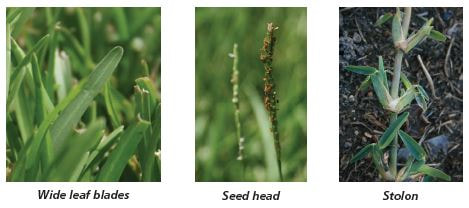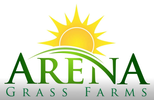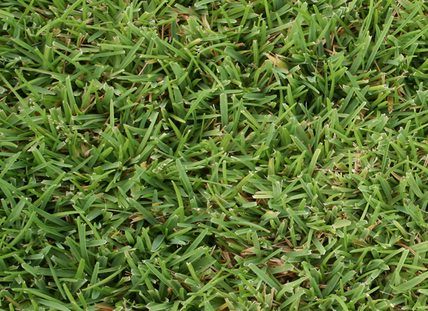St. Augustine Grass in Louisiana

Description
St. Augustine grass (Stenotaphrum secundatum [Walter] Kuntze) is a common perennial warm-season turfgrass grown in Louisiana. St. Augustine grass has a low tolerance for cold temperatures but is well-suited to warm, humid weather, making it a popular choice among homeowners. It also has greater shade tolerance among warm-season turfgrasses. St. Augustine grass aggressively spreads through stolons (aboveground stems) and can be established via plugs or sod.
Identification
St. Augustine grass is a dense, coarse-textured turfgrass with folded, medium-to-dark green leaves. Leaves are oppositely arranged on the stolon and have a wide, rounded tip. It has thick, singular seed heads, which extend slightly above the leaf blades and produce small, white-brownish flowers. St. Augustine grass produces robust stolons (aboveground stems), which allows it to spread laterally.
Growing Conditions
Soil Type: Grows in various soil types that have moderate fertility and good drainage.
Soil pH: Prefers soil that is very slightly acidic (< pH 7) to neutral (> pH 7), with soil pH ideally around 6.5. Always follow soil test recommendations to achieve desired soil pH.
Light: St. Augustine grass performs best in full sun but can tolerate moderate shade.
Growth Rate: Spreads quickly and vigorously via stolons.
Maintenance Requirements
Mowing and Traffic: Mow at 2.5 to 3 inches routinely during the growing season. Never remove more than one-third of the leaf blade height at one mowing. Mowing St. Augustine grass at the appropriate height is key in preventing scalping and reducing weed encroachment.
Fertilization: Fertilize with up to 3 pounds of nitrogen per 1,000 square feet per year. Fertilizer should be applied from midspring to midsummer. Never apply more than 1 pound of nitrogen per 1,000 square feet per application. Nitrogen will result in faster St. Augustine grass growth so applying lower nitrogen rates may be advisable. Follow soil recommendations for proper fertility.
Irrigation: Naturally occurring rainfall may provide sufficient water for maintaining a healthy turfgrass in normal years, but irrigation may need to be applied to prevent plant water stress during drought periods.
Dethatching and Aeration: Thatch can develop over time and may need to be reduced through vertical mowing. Compaction can form more quickly on finer-textured soils and in areas where there is high traffic. Dethatching or aeration need to be performed in late spring to summer.
Establishment Methods
Establishing St. Augustine grass in the lawn can be achieved via plugs or sod. Sodding is the most commonly used method for St. Augustine grass establishment. No commercial St. Augustine grass seed is currently available in Louisiana.
Plugs: Purchase or create plugs from sod and plant each piece about 1 foot apart. Irrigate, fertilize and apply weed control as necessary until established.
Sod: Purchase sod and lay it on a smooth soil surface. Irrigate frequently after laying sod and continue to irrigate as needed until sod roots are established.
St. Augustine grass (Stenotaphrum secundatum [Walter] Kuntze) is a common perennial warm-season turfgrass grown in Louisiana. St. Augustine grass has a low tolerance for cold temperatures but is well-suited to warm, humid weather, making it a popular choice among homeowners. It also has greater shade tolerance among warm-season turfgrasses. St. Augustine grass aggressively spreads through stolons (aboveground stems) and can be established via plugs or sod.
Identification
St. Augustine grass is a dense, coarse-textured turfgrass with folded, medium-to-dark green leaves. Leaves are oppositely arranged on the stolon and have a wide, rounded tip. It has thick, singular seed heads, which extend slightly above the leaf blades and produce small, white-brownish flowers. St. Augustine grass produces robust stolons (aboveground stems), which allows it to spread laterally.
Growing Conditions
Soil Type: Grows in various soil types that have moderate fertility and good drainage.
Soil pH: Prefers soil that is very slightly acidic (< pH 7) to neutral (> pH 7), with soil pH ideally around 6.5. Always follow soil test recommendations to achieve desired soil pH.
Light: St. Augustine grass performs best in full sun but can tolerate moderate shade.
Growth Rate: Spreads quickly and vigorously via stolons.
Maintenance Requirements
Mowing and Traffic: Mow at 2.5 to 3 inches routinely during the growing season. Never remove more than one-third of the leaf blade height at one mowing. Mowing St. Augustine grass at the appropriate height is key in preventing scalping and reducing weed encroachment.
Fertilization: Fertilize with up to 3 pounds of nitrogen per 1,000 square feet per year. Fertilizer should be applied from midspring to midsummer. Never apply more than 1 pound of nitrogen per 1,000 square feet per application. Nitrogen will result in faster St. Augustine grass growth so applying lower nitrogen rates may be advisable. Follow soil recommendations for proper fertility.
Irrigation: Naturally occurring rainfall may provide sufficient water for maintaining a healthy turfgrass in normal years, but irrigation may need to be applied to prevent plant water stress during drought periods.
Dethatching and Aeration: Thatch can develop over time and may need to be reduced through vertical mowing. Compaction can form more quickly on finer-textured soils and in areas where there is high traffic. Dethatching or aeration need to be performed in late spring to summer.
Establishment Methods
Establishing St. Augustine grass in the lawn can be achieved via plugs or sod. Sodding is the most commonly used method for St. Augustine grass establishment. No commercial St. Augustine grass seed is currently available in Louisiana.
Plugs: Purchase or create plugs from sod and plant each piece about 1 foot apart. Irrigate, fertilize and apply weed control as necessary until established.
Sod: Purchase sod and lay it on a smooth soil surface. Irrigate frequently after laying sod and continue to irrigate as needed until sod roots are established.
St. Augustine Sod in Louisiana
Arena Grass Farms 1 (888) 788-1448 682 Maraist Rd, Crowley, LA 70526

